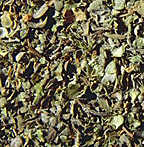 Marjoram is a timid flavour. When was the last time you saw a dish on a restaurant menu featuring this herb the same way basil, oregano, and chervil get promoted? Pasta with fresh marjoram sauce? I don’t think so. Marjoram is a timid flavour. When was the last time you saw a dish on a restaurant menu featuring this herb the same way basil, oregano, and chervil get promoted? Pasta with fresh marjoram sauce? I don’t think so.
However this plant can be very pleasant when fresh and a little sawdusty when dried. Its flavour is dispassionate. It not as lusty or bitter as oregano, to which it is related, or as strong as sage for which it is sometimes subsituted, and it is usually sweeter than thyme.
Despite such misgivings, marjoram is a perfect herb for those who like a little seasoning without the stronger flavour punch that many herbs give.
The early Greeks considered marjoram a herb of happiness. They planted it on graves to assist their loved ones in the next world. In later times, fresh sweet marjoram leaves were routinely sprinkled around royalty as an air freshener. Several cultures serve marjoram tea as a digestive.
There are several kinds of marjoram. They include cultivated and wild varieties. The most common one is sweet marjoram which has a botanical name of origanum majorana. In warm climates it is a perennial but often the plants that grow in cooler climates have less of the essential oils and are consequently sweeter.
Marjoram is fairly easy to grow. Use the leaves when the plant is 10—15 cm. tall and before the flowers had budded. Many chefs rub fresh marjoram leaves on meat before it is roasted. Its mild flavour also compliments onion and garlic. If used fresh, add the leaves to a sauce or stew shortly before serving. Otherwise, this herb’s delicate flavour will dissipate in the cooking. 
|

